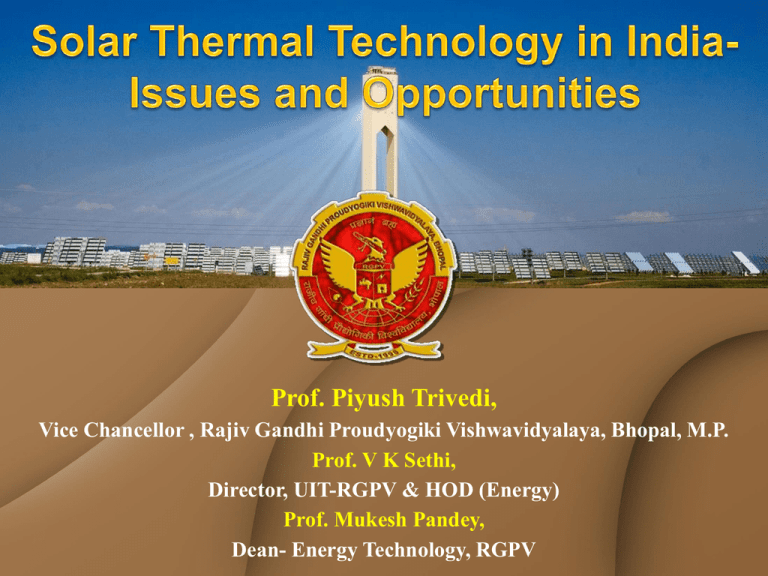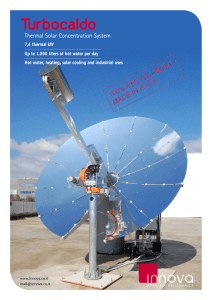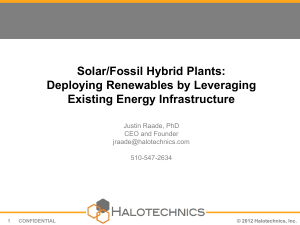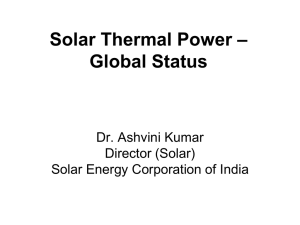icore 2013
advertisement

Prof. Piyush Trivedi, Vice Chancellor , Rajiv Gandhi Proudyogiki Vishwavidyalaya, Bhopal, M.P. Prof. V K Sethi, Director, UIT-RGPV & HOD (Energy) Prof. Mukesh Pandey, Dean- Energy Technology, RGPV INTRODUCTION • The present paper deals with Energy Efficient & Environmentally benign technologies, the Green Power Technologies of concentrated solar power for a sustainable energy security. • Solar Thermal Technology related Issues and Opportunities discussed • Reduction of Coal Consumption in Thermal Power Plant through Cross Linear - CSP system, capable of producing steam at high (>=6000C) temperature. • Also demonstrating the Cross Linear - CSP technology as a viable mean for the Energy Security & achieving the targets of Jawaharlal Nehru National Solar Mission. Mission Energy Security and Energy independence • • • • • Climate Change – Nature’s Fury Solar for Power generation & irrigation High Efficiency CNT Based PV Cells Hydrogen as Fuel for future Accelerated Program on Thorium based Nuclear Reactor • Clean coal Technologies like SCR, IGCC • Bio-fuels for Railways and Mass Transport • Energy Security by 2020, Energy Independence by2030 ….Ref.: Address by President of India on the eve of Independence Day Stabilization Wedges 16 Billions of Tons (GtC) Carbon Emitted per Year 16 GtC/y Eight “wedges” 8 Historical emissions Goal: In 50 years, same global emissions as today 8 GtC = 8000 Million Tons Per Annum of Carbon = 8000x44 / 12 = 29300 MTPA of CO2 Flat path 1.6 0 1950 2000 2050 2100 Wedge Strategies in 4 Categories A “wedge” is a strategy to reduce carbon emissions that grows in 50 years from zero to 1.0 GtC/yr. The strategy has already been commercialized at scale abroad. Energy Efficiency & Conservation Fossil FuelBased CCT Strategies Stabilization Stabilization Triangle Nuclear Power 2012 2062 Renewables & Bio-storage The Four Dimensions of Low Carbon Technologies • 1: Low Carbon Technologies (LCT) Renewable Energy Technologies - Plans for Energy security and Environmental Sustainability • 2: Clean Development Mechanisms (CDM)/ Green Certificates / RPO Barriers, Policy & Action Plans and Roles of Market PlayersImpact of Low-Carbon Life Style on Climate Change, Other Mechanisms beyond Kyoto Regime : 2012 • 3: Clean Coal Technology (CCT) Mega Power Projects based on Supercritical & IGCC Technologies • 4: Carbon Capture& Sequestration (CCS) Impact R & D Projects & Technology Issues – Technology Transfer Strategies. Grid Interactive Renewable Power Renewable Energy Programme/ Systems Target for 2012-13 (MW) Total achievement during 2012-13 (MW) Wind Power 2500 1698.8 Cumulative achievement up to 31.08.2013 (MW) 19,779.15 Small Hydro Power 350 236.93 3,711.75 Biomass Power 105 114.7 1,264.80 Bagasse Cogeneration 350 352.20 2,337.43 Waste to Power (UrbanIndustrial) Solar Power (SPV) 20 6.4 99.08 800 754.14 1,968.84 Total 4125 3163.17 29,161.05 Though RE is about 13% of Total Installed Capacity (2,25,793.10 MW) ; but this contribution has a major social and economic impact . The low PLF of RE Plants is a matter of concern. The growth of clean energy technologies for mega Power generation, both Solar Thermal and PV, Clean Coal Technologies, are key to the success Green Power Mission for abating Climate Change CAPACITY ADDITION -12TH PLAN IN INDIA (2012-2017) • Report of Working Group on Power for 12th Plan expected shortly. Likely requirement of capacity addition during 12th Plan - about 80,000 MW. ( RES – 29,000 MW; 55% Capacity - Private Sector; 40% - coal based supercritical technology) • Target of energy saving through DSM and Energy Efficiency measures about 60 BU at bus-bar, avoided peaking capacity about 12,000 MW. • Proposed targets in JNNSM: 22,000 MW by 2022 – 100 GW (100000 MW) by 2030 or 10-12% of total power generation capacity estimated of that year – 4-5GW of installed solar manufacturing capability by 2017 8 Thermal storage • All CSP plants have some ability to store heat energy for short periods of time and thus have a “buffering” capacity that allows them to smooth electricity production considerably and eliminate the shortterm variations other solar technologies exhibit during cloudy days. • Recently, operators have begun to build thermal storage systems into CSP plants. The concept of thermal storage is simple :throughout the day, excess heat is diverted to a storage material (e.g. molten salts). When production is required after sunset, the stored heat is released into the steam cycle and the plant continues to produce electricity Project Objectives Broad Objective Technology Demonstration of Cross Linear – Concentrated Solar Power in Indian conditions through a 30 kWth Test Unit at RGPV, Bhopal Specific Objectives Demonstrate High Temperature (>=6000C) attainment of CL-CSP Optimize Simulation Technology of CL-CSP Utilize to develop 1 MWe Test Plant and Commercial Plant of 20 MW size Strengthen Indian-Japanese technical collaboration Promoting Industry – Academia joint venture project in true sense Collaborating Partners Universities/Institutions Rajiv Gandhi Proudyogiki Vishwavidyalaya, Bhopal Delhi Technological University, Delhi SolarFlame Corporation, Tokyo, Japan Asia Sunbelt Development Association, Japan Industrial Partners Bergen Solar Power & Energy Ltd, Gurgaon Toyo Engineering Corporation, Japan RICOH Corporation, Japan Concept of CL (Cross Linear) solar concentration system Linear Fresnel (LF) system Low construction cost Hybridization High concentration (High efficiency) Central tower system Cross Linear (CL) system Bird view of CL system for large scale (30MW) CSP plant Receiver CO2 (600 ºC) High temp. concentration field Low temp. concentration field 300 m 250 m Heliostat field CO2 (200 ºC) High temperature with CL solar concentration system N Receiver line (E-W) N W S N N Mirror line (N-S) N N N N E S S Increase in mirror line S S Increase in mirror facet S S S More Solar Energy Larger concentration Sun tracking mechanism on CL solar concentration system Linear Fresnel (LF) system E W Mirror with curvature Mirror line Sun tracking Receiver with reflector S Individual mirror facet Sun tracking N Structure of CL solar concentration system receiver CPC E W Quartz glass Receiver with reflector S N Receiver tube Comparison of solar concentration on CL and LF systems Optical simulation based on Monte Carlo Ray-tracing method ① LF system Mirror: 1m×1m×64 =64m² N S N 1×8+0.2×7=9.4m Mirror: 1m×8m×8 =64m² S 1×8+0.2×6+0.5=9.7m 8m ② CL system 1×8+0.2×6+0.5=9.7m ③ Improved CL system 14.1m N S 1×8+0.2×7=9.4m Mirror: 1m×1m×64 =64m² • Mirrors on the north side have higher cosine efficiency than those on the south side. Simulation result of solar concentration for CL and LF systems Daily Collected power on receiver plane LF system ①リニアフレネル型 30 CL system ②クロスリニア型 Improved CL ③クロスリニア型(改良版) system power (kW) Collected 照射熱量/kw 25 ・②CL system:①LF system 1.52 times on culmination 1.22 times on 1-day ・③Improved CL system: ①LF system 1.76 times on culmination 1.25 times on 1-day 20 15 10 5 0 5 7 9 11 13 時刻/h(h) Time 15 17 19 Comparison with other Technologies Temperature Cross Linear Tower, Trough, Linear Fresnel 300-600 deg C Tower: 600 deg C Trough: 400 deg C Linear Fresnel: 500 deg C Concentration 100-1000 Tower: 300-1000 Trough, Linear F <100 Thermal Fluid Liquid: Water, Oil Tower: Stem, Molten Salt Gas: Air, Steam, CO2 Trough: Oil, Steam, Molten Salt Linear Fresnel: Steam CL Heliostat CL Receiver Axis: 1.01 Tower: 2.0/high precision Control precision: Moderate or Low Trough, Linear F: 1.0/middle precision Cavity, CPC , Pipes Tower: cavity Trough: vacuum pipe Linear Fresnel: pipes, CPC, cavity Application – Cross Linear/CSP CL-CSP Technology has the ability to produce temperatures in excess of 650 deg C, hence it has widespread application in replacing costly Coal used by Thermal plants in India Case Study – Thermal Power Plant Coal Saving Solar Thermal is used to supply Auxiliary Load of coal fired thermal power plant Installed Generation Capacity in India - Coal Fired Thermal Plants (Source: Power Info-bank 2012) Auxiliary Load of thermal Power Plant (Electric + Thermal) Total Auxiliary Load for all Coal-fired power plant Total units per hour Coal Consumed Coal Consumed in one hour Coal Cost Coal Consumed in one hour Available Sun radiation on average per day Coal saving incase solar thermal energy is used to supply auxiliary load Total Sunny days Cost of Coal consumed in one year Minimum Net Saving with Auxiliary load of Solar (CL-CSP) with Thermal Storage Facility 105.00 GW 10% 10.50 105.00 GW Lacs units/hr 0.70 kg/unit 7350.00 tons/hr 6.00 Rs./Kg 441.00 5.00 2,205.00 300.00 6,615 Say about 7000 Cr. Lac Rs./Hr. hours Lac Rs./day days Cr Rs. Fuel Switching CSP Solar Thermal Power for Feed Heating Coal saving 8 – 10 % CSP Solar Thermal Power for Auxiliary Steam Production / Auxiliary Power Generation Fuel Substitution in Old Polluting Thermal Power Plants having low PLF by Solar Thermal ………………………………………………………………………………………………………………………… Saving potential in 30% Old capacity burning 120 Million Tons per Annum Coal :by 10% Coal Substitution= 12 Million Ton x Rs. 6000 per Ton = 7200 Cr/ Annum Economics of the Project By employing CL-CSP in 10% of the dormant coal fired power plants, coal worth billions of dollars can be saved 30% of the Coal Fired Thermal Plants fall under the below category CL-CSP technology can be implemented in Coal Fired Thermal Plants having shortage of coal supply Current installed capacity of Coal Fired Thermal Plants in India is 105 GW. In Rs. the total Coal cost comes to around 2 Lac 40 thousand Cr.. Consumption of coal per year is approx. 411 Million Tonnes worth Rs. 2400 billion. OTHER CL-CSP RELATED OPPORTUNITIES IN THERMAL POWER STATION (1) Coal Gasification through Solar Steam in an IGCC Power Plant. (2) Optimizing condenser performance in dry cooling towers. (3) Optimizing feed heaters performance through Solar Heat Substitution. (4) Optimizing auxiliaries’ consumption through Solar Power. (5) Reduction in make-up water consumption through deslineation in coastal power plants. 11 • Global hub for manufacturing CSP in our Heavy Industries • Global test facilities – Different climatic conditions in MNRE Centers – Technical man power • Large scale Power plants – 4-5 GW by 2020 is easily possible – Potential States -Rajasthan, Gujarat, Maharashtra, Karnataka, MP, Haryana, AP, TN Rajiv Gandhi Proudyogiki Vishwavidyalaya , MP, India Mile Stone of CSP Technology CSP is poised to become a significant player in the renewable electricity generation in countries where a significant solar energy resource is available, such as those near desert and equatorial regions. Combined generation of electricity and heat by CSP is particularly interesting, as the high value solar input energy is used with the best possible efficiency, exceeding 85 %. CL-CSP can be game changer in CSP Technology • Optimization of Water Supply for Power Generation. • Low Turbine efficiency due to low steam parameters. • Availability of Power Grid in the vicinity. • Land availability • Poor infrastructure in the remote deserts for material transport and habitat of work force. Rajiv Gandhi Proudyogiki Vishwavidyalaya , MP, India Technology Assessment ……… Viability/grid parity is a question as concerned. It will take a little longer than PV. A careful analysis needs to be carried out for the determination of an economically optimized project site that not only depends on the solar irradiance (DNI) but on many other influencing parameters. Designing the projects to meet specific needs economic benefit using high efficiency CSP technology. Land is a scarce resource in India and per capita land availability is low. The amount of land required for utility - scale solar power plants, currently is about 6 acres per MW. far as CSP at is an Conclusion CL-CSP is perhaps the only technology in the world which can readily give temperature in excess of 650 deg C. The 30 kW Pilot Plant at RGPV will pave way for 1 MW to 20 MW commercial plant under planning at Panipat Thermal Power Station. In India it can be used to replace costly Coal in Thermal Power Plants Going by the current installed capacity of Coal Fired Thermal Power Plants of 105 GW, around 400 Million Tons of coal. And if we target 10% of the dormant plants (30% of total plants, which are old) the total coal saving every year comes out to be 12 Million Tons every year amounting to around Rs. 7200 Cr. Visit our Energy Park at RGPV Bhopal Thanks for your kind attention








